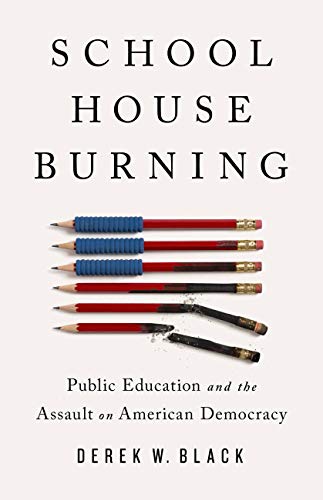 School House Burning: Public Education and the Assault on American Democracy
School House Burning: Public Education and the Assault on American Democracy
by Derek W. Black, Hachette Book Group, New York, N.Y., 2020, 309 pp. with index, $28 hardcover
America’s founding fathers provided two gifts to the future: democracy and public education. Each gift has been challenged often, but public education survives and thrives.
In
School House Burning, Derek Black, noted constitutional law professor at the University of South Carolina, shows that knowing the history of this journey is vital for confronting the threats and affirming public education as “the foundation of our constitutional democracy..”
Black speaks to modern debates about the linkage of voting rights and education. He documents the evolution of public education debates from the time of our founding, through the Civil War, Reconstruction, Jim Crow, the Civil Rights movement to state-level actions litigating education as a right. He examines the ways vouchers and charter schools have evolved from the tactics of segregationist to become tactics to alter America’s democratic ideals.
Black identifies key principles that various state courts have developed to protect public education.
School House Burning provides useful knowledge for leaders grappling with the longstanding attempts used by some to block students from developing essential citizenship skills. Learning how those fighting equitable education for all students have operated provides valuable guidance for those pushing for an equitable, strong system of public schools.
Reviewed by Brian L. Benzel, retired superintendent and leadership mentor, Redmond, Wash.
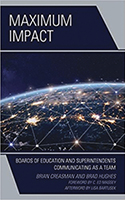 Maximum Impact: Boards of Education and Superintendents Communicating as a Team
Maximum Impact: Boards of Education and Superintendents Communicating as a Team
by Brian Creaseman and Brad Hughes, Rowman & Littlefield, Lanham, Md., 2020, 90 pp., $60 hardcover, $30 softcover
Authors Brian Creaseman and Brad Hughes in their book,
Maximum Impact: Boards of Education and Superintendents Communicating as a Team, outline the various types of communication necessary for a school district to be successful and why such discourse can lead to improved relationships both within and outside of a school system. The authors draw on real-world situations to drive home their points on the importance of communication.
The book is comprised of several concise chapters. Each chapter addresses a specific aspect of communication, such as conveying a message to the media. This allows the reader to return to a specific chapter when a similar issue of communication arises in his or her own district, drawing on the experiences described within that topic.
This is followed by a section called “Practical Strategies” and concluding segment referred to as “Key Takeaways.” Each section highlights what issue was addressed in the chapter through synthesis or example.
Our society’s growing reliance on social media — coupled with the more traditional methods of disseminating community information like newsprint and broadcast journalism — provides increased scrutiny for superintendents and school boards.
Maximum Impact provides school leaders with a series of templates for navigating the often-turbulent waters of information and misinformation.
Reviewed by Marc Space, retired superintendent, Ranchos de Taos, N.M.
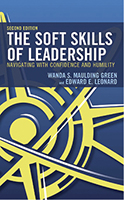 The Soft Skills of Leadership: Navigating with Confidence and Humility, Second Edition
The Soft Skills of Leadership: Navigating with Confidence and Humility, Second Edition
by Wanda S. Maulding Green and Edward E. Leonard, Rowman & Littlefield, Lanham, Md., 2019, 146 pp., $59 hardcover, $29 softcover
In the second edition of Wanda Maulding Green and Edward Leonard’s,
The Soft Skills of Leadership: Navigating with Confidence and Humility, the reader is taken on a journey via the very relatable concept of GPS navigation. Green and Leonard are leadership trainers and coaches for both K-12 and higher education practitioners. Further, Green serves as a University of South Alabama faculty member and Leonard teaches leadership courses at William Carey University.
The Soft Skills of Leadership reads like a research paper while providing real-life examples. The soft skills of leadership include all those qualitative ideals and characteristics which a leader either possesses or strives toward, whether innate or acquired via deliberate reflection and/or learning.
Leadership Acumen (LSA) is the overarching construct that encompasses the heart of the soft skills addressed throughout the book. Leadership competence is often predicated on the successful perception of the “soft” skills a leader possesses; however, there is a marked commonality across the world of the specific skills that ultimately contribute to a leader’s success.
The Soft Skills of Leadership provides readers with specific examples to assist in developing and expanding skills as well as how to “recalculate” the leadership sojourn when faced with a roadblock. Wherever district leaders may be in their personal journeys, this book provides the research into the importance of nurturing the soft skills.
Reviewed by Lisa M. Antunes, superintendent, Hillsborough, N.J.
 Building A Winning Team: The Power of a Magnetic Reputation and the Need to Recruit Top Talent in Every School
Building A Winning Team: The Power of a Magnetic Reputation and the Need to Recruit Top Talent in Every School
by Joseph Jones, Salome Thomas-El and T.J. Vari, Rowman & Littlefield, Lanham, Md., 2020, 140 pp. with index, $30 softcover, $60 hardcover
Joseph Jones, Salome Thomas-El and T.J. Vari partner in the new book,
Building a Winning Team: The Power of a Magnetic Reputation and the Need to Recruit Top Talent in Every School. The authors have previously worked together to co-author
Passionate Leadership: Creating a Culture of Success in Every School.
All three authors have experience in a variety of educational roles including classroom teachers, building level principals and district office leaders. Throughout the book they effectively incorporate their experiences along with best practice research regarding the importance of having highly effective teachers in every classroom.
The book is organized into twelve chapters with a concluding chapter, “focus questions,” providing the reader with the opportunity to reflect on the content from the chapter and compare it to current policies and practices.
Throughout the book two key themes are consistently reinforced. First, the importance for schools and school districts to consistently and effectively “tell your story.” Not only is this imperative from a public relations standpoint in helping the public understand the great things happening in your school each day, but it is equally as important in the successful marketing of your school. Your brand and reputation will directly impact your ability to attract top teachers.
Secondly, the idea that hiring teachers is not something you do for just a couple of months each spring, but year-round intentional focus aligning your staff recruiting process with your core mission, vision and school culture.
As a superintendent I found the structure and organization of the book to be very helpful. In addition to the end-of-chapter reflective questions, the authors provide multiple strategies and examples that could be used in your school district to help evaluate and improve your opportunities to attract and retain top teaching talent.
The book could also be an effective tool for building principals, providing them with a simple and quick-to-read resource as they navigate the consistent challenges associated with attracting and retaining world-class educators.
Reviewed by Justin B. Henry, superintendent, Goddard Public Schools, Goddard, Kan.
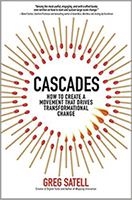 Cascades: How to Create A Movement That Drives Transformational Change
Cascades: How to Create A Movement That Drives Transformational Change
by Greg Satell, McGraw Hill, New York, N.Y., 2019, 236 pp., $30 hardcover
Cascades was an immediately riveting book. Its lessons are based on the learnings from two disparate uprisings: Occupy in the United States motivated by a stand against Wall Street wealth and the 1 percent, which for all intent and purposes fizzled, and the Ukrainian Orange Revolution which led to the fall of dictator Slobodan Milošević.
The book grounds itself on the scientific research of networks using the synchronicity of fireflies and snowy tree crickets. The author uses this research to demonstrate the power of small groups and loose connections and how they can be harnessed for change. While not all small groups rise to the level of a national revolution, networks — loosely connected, but united by a common purpose — can led to a great change.
The book lays out that time and effort may be best used on small groups of committed followers who can be galvanized by an inspiring mission and message. These small groups coalesce and cascade to drive transformational change.
The research and stories of success from the book lay a clear path forward for change for a public-school superintendent: identify change, make a plan, build a network of small groups, share a galvanizing mission. Based on
Cascades, our team immediately revamped a communication plan to focus more on galvanizing small, loosely connected groups.
Reviewed by C. Todd Cummings, superintendent, South Bend, Ind.
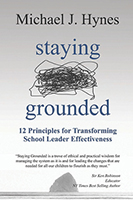 Staying Grounded: 12 Principles for Transforming School Leader Effectiveness
Staying Grounded: 12 Principles for Transforming School Leader Effectiveness
by Michael J. Hynes, Code Breaker, Hot Sulphur Springs, Colo., 323 pp., $23.99 softcover
At no point in history has it been more important to tell educational leaders to take care of themselves, nurture relationships and remember their purpose.
Staying Grounded, by Michael J. Hynes, a veteran superintendent on New York’s Long Island, does that and more.
The 12 principles of focus in his text provide the groundwork for maximizing one’s own strengths to serve the school community. While many leadership texts help school leaders tune up the system around them — primarily school improvement processes and school culture —
Staying Grounded helps to center the leaders themselves.
The first principle, “take care of yourself,” is analogous to the directive of airline attendants: put the oxygen mask on yourself before attempting to put one on others. As none of us could effectively support others if the cabin is depressurized if we are incapacitated, we also can’t serve our school communities if our physical and mental health are less than optimal. This, of course, does not equate to self-centeredness or self-preservation, as the seventh principle reminds us, we are here to serve others.
Subsequent principles focus on attitude, relationships, purpose, a philosophy of education, routines and emotional stability versus cognitive ability. Principle 5, “step outside your comfort zone,” reminds the leader that change is inevitable and that embracing change is both mentally healthy and important to personal and organizational success.
Other principles relate to important understandings for the leader to develop: empathy (“walk in their shoes”), branding and social media, and human development. The book provides education leaders with a multi-dimensional approach for introspection that can lead to strengthening leadership capacity.
Reviewed by Judy Paolucci, superintendent, Smithfield Public Schools, Smithfield, R.I.
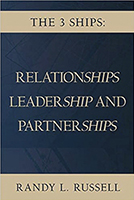 The 3 Ships: Relationships, Leadership, and Partnerships
The 3 Ships: Relationships, Leadership, and Partnerships
by Randy L. Russell, RLR Leadership Consulting, Spokane, Wash., 2020, 135 pp., $14.99 softcover
Randy Russell’s
The 3 Ships: Relationships, Leadership and Partnerships provides a practical, succinct approach for those seeking to navigate their leadership role. Russell applies his background as a superintendent in Washington to share core leadership attributes applicable to work, family and personal life situations.
Building a key set of relationships is “the fundamental glue for our society” because they are essential to “increasing our emotional well-being, creating stability, and learning how to be a good friend.” Russell further notes that growing and developing sound relationships creates necessary trust built upon compassion, caring and understanding.
Examining your personal approach to leadership requires developing clarity about your purpose. Identifying and affirming this purpose drives numerous other leadership actions. Russell uses his own experiences to explore practical leadership functions that help create strong, successful schools and other organizations. Using a variety of scenarios, the author suggests guiding questions that will help the reader improve her/his leadership.
Partnerships with colleagues and an array of public and private entities provide mutually beneficial assistance and support. Using his own school district, Russell shares examples of effective partnerships with colleagues, his governing board, businesses and other organizations built upon clear expectations, teamwork, growth potential and integrity.
Russell’s experience and personal commitment to learning and improvement make
The 3 Ships a valuable guide to leadership development. This easy-to-read guide contains templates that allow the reader to customize relationship, leadership and partnership concepts in support of team learning.
Reviewed by Brian L. Benzel, former superintendent, Redmond, Wash.
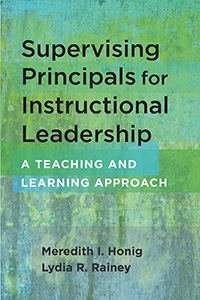 Supervising Principals for Instructional Leadership: Teaching and Learning Approach
Supervising Principals for Instructional Leadership: Teaching and Learning Approach
by Meredith I. Honig, and Lydia R. Rainey, Harvard Education Press, Cambridge, Mass., 2020, 205 pp., $32 softcover
In
Supervising Principals for Instructional Leadership: Teaching and Learning Approach, authors Meredith I. Honig and Lydia R. Rainey have written a book that outlines how district leaders can allow principal supervisors to address instructional leadership with building principals. Every principal needs to learn how to become a better instructional leader and the book outlines research from Honig and Rainey, which shows how supervisors can support principals to become instructional leaders and develop the capacity to lead their own learning.
Honig is a professor of educational policy, organizations and leadership at the University of Washington. Rainey is a research scientist at the same university and director of research for the District Leadership Design Lab.
Educational research, they say, reinforces the idea that teaching is the most important school-related influence on the student learning and that principals’ leadership is essential to helping teachers succeed. This form of principal leadership sometimes called instructional leadership.
Principals strengthen their instructional leadership when they take intentional steps during their workday to learn how to improve that leadership, often alongside others, much like how doctors and other professionals engage in ongoing on-the-job learning with various mentors throughout their careers.
The authors share materials they have developed to support principal supervisors in leading their own learning to take a teaching and learning approach to their work. This includes a professional growth planning process to help principals’ supervisors use standard and various data to develop and implement their own learning plans.
Reviewed by William A. Clark, adjunct professor, educational leadership, Pennsylvania University World Campus, Warren, Pa.
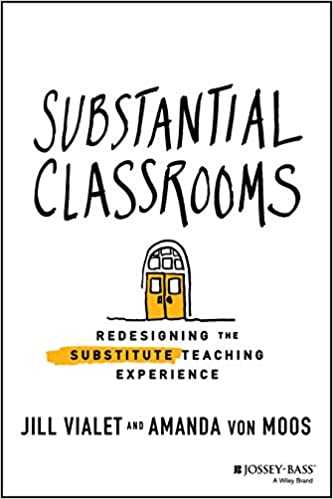 Substantial Classrooms: Redesigning the Substitute Teaching Experience
Substantial Classrooms: Redesigning the Substitute Teaching Experience
by Jill Vialet and Amanda von Moos, Jossey-Bass, San Francisco, Calif., 2021, 224 pp. with index, $24.95 softcover
Jill Vialet and Amanda von Moos’ new book,
Substantial Classrooms: Redesigning the Substitute Teaching Experience offers so much more than the title suggests. Yes, there is a deep dive into improving the teaching and learning experience associated with approximately one year of each student’s academic career, and that’s huge.
But this book is about far more than substitutes. It’s about innovation or, more deliberately, “design.” The book and its lessons seem particularly resonant at this point of inflection in education. As we emerge from the COVID crisis, we ought to be reinventing education, right? But where to start?
Substantial Classrooms provides a case study in attacking the significant, largely untackled problem of substitute teaching and learning through a deliberate design process and shows us how to make easy connections to other challenges within our school systems.
While reading
Substantial Classrooms, for example, I reflected on our district's creation of an educational option for families who did not want virtual school for the 2020-21 school year. In just a few weeks in the summer of 2020, we quickly created a long-term independent study program option. This quick, first iteration has generally been successful, but it is also quite imperfect. I will be asking my team to read
Substantial Classrooms, focusing on the design process, as we move forward with the next iteration for the coming school year.
The concept of "empathy interviews" to understand the perspectives of substitute teachers, classroom teachers, administrative assistants, principals and students is particularly resonant in a district like ours with a strong SEL focus. Effective solutions,
Substantial Classrooms argues, can only be created when perspectives are sought, listened to and integrated.
Why didn't we think of the concept of "empathy interviews" when we developed a "supervised learning group" (a safe, well-equipped space for students to engage in virtual school) for students living in a local homeless shelter? In planning, we talked to everyone — city officials, teachers, principals — except the families. Consequently, we created a solution to a problem that did not match family needs, and no one showed up! The authors share their discovery that the best solutions are very often the ones that cause us to say at the end, "why didn't we think of that before?" To get to that result, starting with empathy interviews makes a lot of sense.
While reading this book, teachers and principals will encounter so much that has been hidden in plain sight simply because we’ve just assumed it has to be that way, or perhaps we’ve never encountered a challenge to how the system is. Vialet and von Moss explore these challenges and then seek to redesign a reality we weren’t even aware we had given up on.
Reading
Substantial Classrooms will fill you with hope, but as we all know, hope is not a strategy.
Substantial Classrooms also provides a process to follow to address substitute teaching and other challenges within your system.
Reviewed by Michael Gallagher, superintendent, Sunnyvale School District, Sunnyvale, Calif.